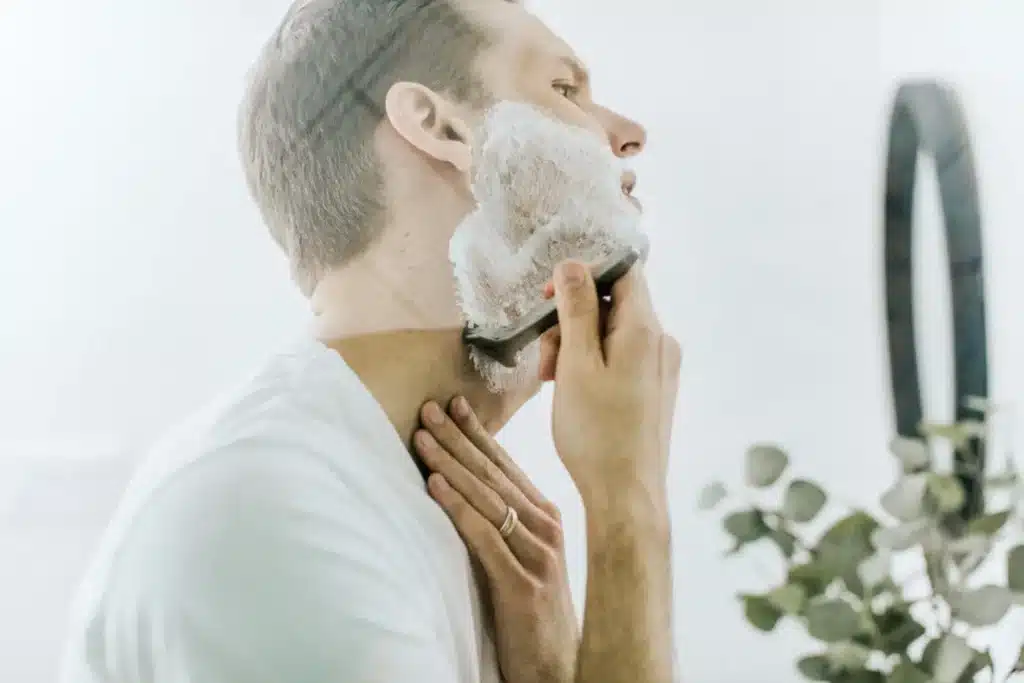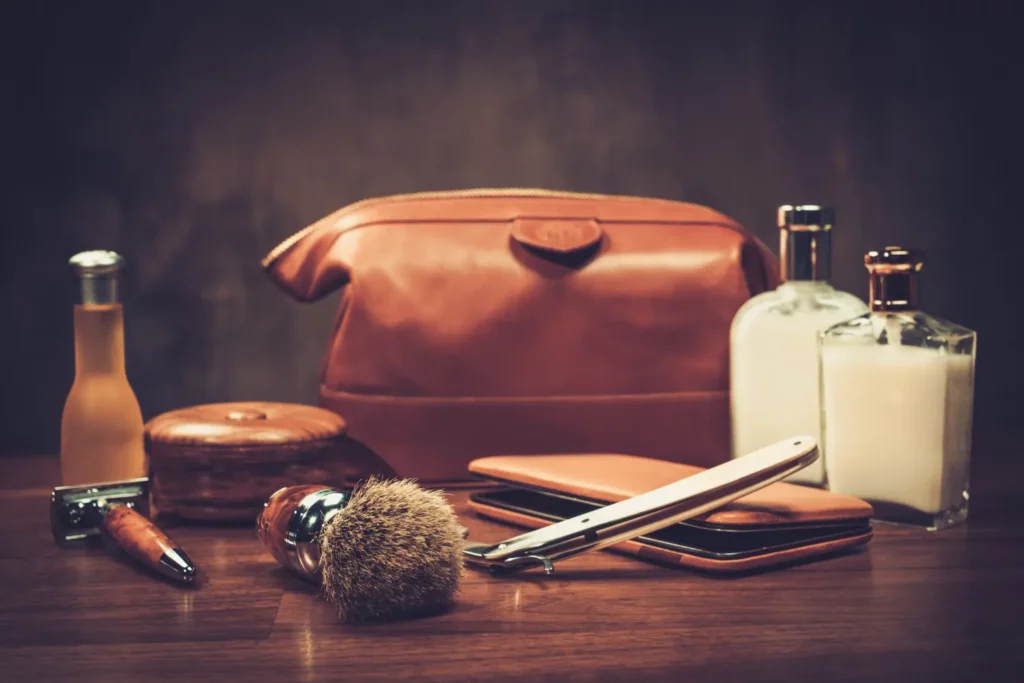Whether you are shaving with a safety razor for the first time or looking to improve your technique, this guide shares many of the fundamental principles for getting the most out of your shave.
While we cover some basic tips like choosing the right blade angle and using proper pressure, we also share some more advanced techniques that will apply to folks of any experience level.
By taking the time to incorporate these tips, you will not only get a closer, more comfortable shave but will also reduce the risk of cuts and irritation, especially for those with sensitive skin.
1. Practice Makes Perfect: Mastering the Safety Razor Shave
Switching from cartridge razors or disposable razors to double-edged safety razors, also known as double-edge razors, might be intimidating for beginners.
However, remember that mastery doesn’t happen after just one try. You’ll find that after about 10 or so shaves with your safety razor, you’ll start getting the hang of it.
The most common problems that beginners face will be the occasional nicks and cuts (we’ll share how to avoid them later on), but with time, you’ll get used to this unique shaving experience and become more confident in your technique.
2. Prepping Your Beard With Hot Water

No matter what shaving tool you are using, prepping your beard is essential. You have two ways to prep your beard for a safety razor shave: a hot towel or a warm shower. Here are some tips for both:
- Hot towel method: Soak a small towel in hot water, wring it out, and place it over your beard for a least a minute or two. If you can, try to compress the towel against your skin to help open up the pores and soften the hairs.
- Warm shower method: Taking a warm shower will also help to prep your beard for a safety razor shave. The steam will help to soften your beard hairs and open up your pores, making it easier for the razor to glide over your skin.
The reason why this is important is that it reduces the amount of tug and pull on your beard hairs.
Gillette estimates that by applying hot water to your face for a few minutes before shaving, you can reduce the force required for the razor to cut hair by up to 70% percent.
3. Using The Correct Angle

One of the fundamental aspects of using a safety razor is finding the correct angle to hold it against your skin. Generally, the optimal angle is anywhere between 30-45 degrees. Holding the razor at this angle will allow the blade to smoothly glide over your skin without causing any irritation or discomfort.
So how do you determine this without having to pull out the protractor? A good rule of thumb is to hold the razor at a 90-degree angle to your face, then tilt it halfway between that and parallel to your skin – this will be 45 degrees. You can adjust the angle slightly from there until you find the sweet spot that works best for you.
Pro Tip: If you have the razor at an angle greater than 45 degrees, it will cause the blade to scrape against your skin, resulting in irritation and could even cause nicks or cuts. If the razor is held less than 30 degrees, it will hardly come in contact with your skin, resulting in an ineffective shave.
4. Safety Razors are Heavy for A Reason
The biggest hurdle that people face is applying too much pressure using a safety razor. Remember, the weight of the razor itself is designed to provide enough pressure for a close shave. When using a safety razor, you are simply gliding the razor over your skin, letting the weight of the razor do the work for you. Very little if any pressure should be applied with your hand.
Some folks recommend that you hold the razor with just two fingers along the grip to avoid applying too much pressure. With practice, you’ll learn to trust the weight of the razor to achieve a closer shave without causing irritation or cuts.
Even if you have thick or dense beard hair, additional pressure is rarely needed.
Transitioning from a multi-blade cartridge razor? It’s important to note that the technique is quite different between a cartridge razor and a safety razor. With a cartridge razor, you need to apply pressure to get a close shave. But with a safety razor, you should avoid applying pressure and let the weight of the razor do the work for you. This can make the transition a bit challenging, but with practice, you’ll find that the results are well worth it, as using a single blade often results in less irritation.
5. Short Strokes for Better Precision and Control

While safety razors aren’t as susceptible to clogging as other types of razors, it’s still important to use short strokes while shaving. Short, controlled strokes provide better precision and control during your first pass and second pass.
This allows you to concentrate on maintaining the correct angle and helps avoid applying too much pressure, which can lead to skin irritation and razor bumps.
6. Finding the Perfect Blade: Test Multiple Safety Razor Blades
Not all safety razor blades, or double-edge razor blades, are created equal, and different brands might work better for your particular beard type and skin sensitivity. Online shops like Amazon, Maggard Razors, and West Coast Shaving offer sampler packs of various blade brands, which allows you to test out different blades without having to commit to a full pack of a specific brand.
When trying out a new blade, make sure to go through at least three or four shaves with it to get a good idea of how it performs. Some blades may feel too aggressive or too mild, while others may cause irritation or razor burn. It’s important to find the right blade for your unique needs, so don’t be afraid to experiment a little bit.
And when you find a blade that works well for you, stick with it!
7. Taking the Path of Least Resistance: Shave with the Grain
Shave with the grain, which means in the direction of hair growth, to minimize the risk of ingrown hairs, razor burn, and other types of skin irritation as suggested by the American Academy of Dermatology.
Worth noting is that everyone’s facial hair growth pattern is different, so take the time to figure you can keep track of your shaving routine and learn the best way to shave to minimize irritation.
This rule holds true whether you are shaving your face, chest, legs, or head.
8. Keep it Clean: Rinse Your Razor Throughout the Shave
When your safety razor, including the razor head, begins to clog with shaving cream, gels, and hair, flip the razor to use the other side of the blade.
Periodically rinse your razor in warm water to keep it clean for an optimal shave. This will ensure that the blade remains sharp and effective and also helps prevent skin irritation from the buildup of shaving cream and hair.
9. Don’t Neglect Post-Shave Care

By and large, shaving is a traumatic experience for your skin, even if you’re using a high-quality safety razor. That’s why it’s essential to take care of your skin after shaving. Rinse your face with cold water and apply a gentle aftershave balm or lotion to soothe and moisturize the skin.
Avoid using products with harsh chemicals or fragrances, as they can irritate your skin and cause redness or breakouts.
Instead, look for products that contain natural ingredients like aloe vera, chamomile, and witch hazel that have soothing and healing properties.
It’s also important to keep your razor clean and dry to prevent bacteria buildup, which can cause infections and skin irritation. Lastly, remember to safely dispose of your used blades using a blade bank to avoid any accidents.
10. Every Razor is Different: Find Your Ideal Safety Razor
Sometimes a safety razor just isn’t the right fit for everyone. Some people may find that certain brands or models of safety razors work better for their skin and beard type than others. If you’re not satisfied with your current safety razor, don’t give up on safety razors altogether. It might just take some trial and error to find the perfect fit for you.
Consider trying out different brands, models, handle lengths, or weights to find what works best for you.
Remember that a high-quality safety razor is an investment that will last you for years, so it’s worth taking the time to find the right one. And once you find the perfect safety razor for you, maintain it properly by cleaning and storing it in a dry place. This will help prolong the life of your razor and ensure that you get the best possible shaves every time.
11. Enhance Your Shave with Additional Shaving Supplies
Traditional wet shaving is a cathartic experience that can be enhanced with additional shaving supplies.
While technically you can get dry shave with a safety razor, its best to get the essential supplies on hand.
Some popular options include a shaving brush, shaving soap, or cream, and pre-shave oil. While these products may seem like luxuries, they can actually improve the quality of your shave by providing added lubrication and moisture to the skin, making it easier to glide the razor across the face.
A shaving brush can also help lift up the hairs on the face and create a rich lather with shaving soap or cream, which can make the shaving experience more enjoyable and satisfying.
Just like with safety razors, there are many different types and brands of shaving brushes, shaving soap, and pre-shave oil to choose from. Experiment with different options to find what works best for you and your skin.
Given that shaving is a significant part of most people’s grooming routines, it’s crucial to find the right tools, supplies, and techniques to ensure a comfortable and satisfying shave. By following these tips and suggestions, you’ll be well on your way to mastering the art of the safety razor shave.